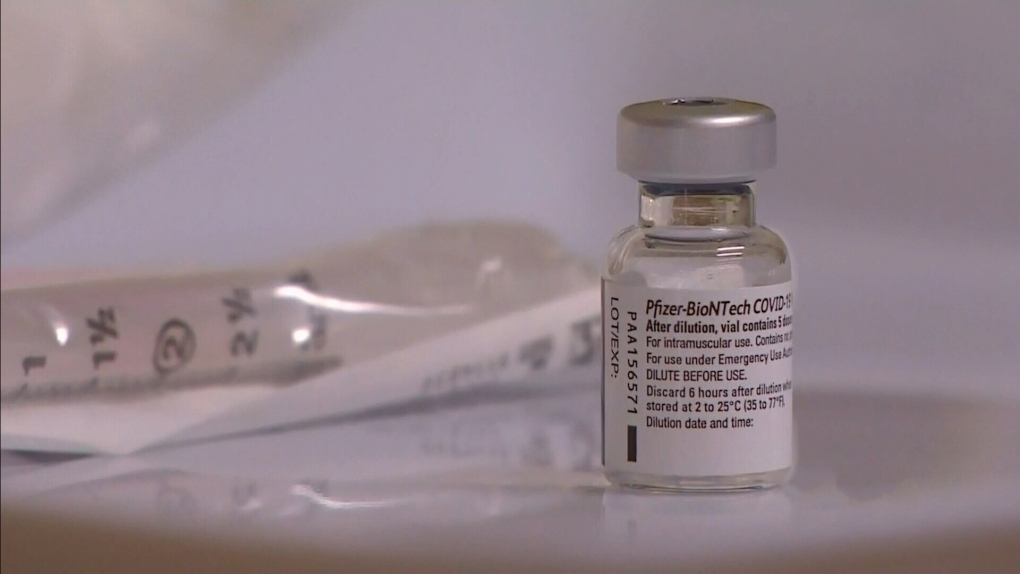Navigation
Install the app
How to install the app on iOS
Follow along with the video below to see how to install our site as a web app on your home screen.
Note: This feature may not be available in some browsers.
More options
Style variation
You are using an out of date browser. It may not display this or other websites correctly.
You should upgrade or use an alternative browser.
You should upgrade or use an alternative browser.
Covid-19 News and Discussions
- Thread starter Yommie
- Start date
Yommie
SpeedLimited
- Oct 2, 2013
- 64,203
- 37,191
- Country of Origin

- Country of Residence

- Thread starter
- #588

B.C. COVID-19 hospitalizations up slightly as province launches latest vaccine campaign
The number of people in B.C. hospitals with COVID-19 rose slightly this week as the province began rolling out its latest vaccination campaign.
B.C. COVID-19 hospitalizations up slightly as province launches latest vaccine campaign


Ian Holliday
CTVNewsVancouver.ca Reporter
Contact
Published April 11, 2024 7:21 p.m. EDT
Share
- Link
- X
There were 141 test-positive COVID patients in hospitals across the province as of Thursday, according to the latest data from the B.C. Centre for Disease Control. That's an increase of nine – or about 6.8 per cent – from last week's total.

The total reported this week remains the third-lowest the BCCDC has reported all year, and it's exactly half as many people as were hospitalized with the disease at this time last year, when there were 282 test-positive patients in B.C. hospitals as of April 6, 2023.
RELATED STORIES
- B.C. launches spring COVID-19 booster program, targeting vulnerable and unvaccinated
- Number hospitalized with COVID-19 in B.C. hits new low for 2024 in latest update
- Anti-vax protester's 'race-based tirade' against security guard wasn't criminal, B.C. judge rules
There were 337 new infections confirmed through lab testing during the week of March 31 through April 6, the most recent "epidemiological week." That's an increase from the 297 new cases confirmed during the previous week.
The percentage of tests coming back positive also rose, reaching 10.6 per cent during the week that ended April 6, up from 9.2 per cent the preceding week.
Other respiratory illnesses have been on a downward trend(opens in a new tab) for the last few months, with new infections and test positivity for influenza and RSV each at or near their lowest levels since the start of the respiratory illness season last fall.
In its statement announcing spring vaccination plans earlier this week, the Ministry of Health said(opens in a new tab) it would be recommending additional shots for older people and those at greater risk of complications from contracting COVID.
"While the peak of the respiratory illness season has passed, the SARS CoV-2 virus continues to circulate at lower levels in the community," the ministry said. "The protection from infection that COVID-19 vaccines provide decreases over time, particularly in older people, so a spring COVID-19 vaccine booster will ensure people stay protected."
Yommie
SpeedLimited
- Oct 2, 2013
- 64,203
- 37,191
- Country of Origin

- Country of Residence

- Thread starter
- #589
Hospitalizations nudge upward in otherwise stable respiratory checkup
Rise in new patients enough to push Ottawa back to high-risk status
Andrew Foote · CBC News · Posted: Apr 11, 2024 11:02 AM EDT | Last Updated: 9 hours agoPeople take advantage of the warm weather at the Bank of Canada plaza in downtown Ottawa on Tuesday. (Sean Kilpatrick/The Canadian Press)
Social Sharing
- X
COVID-19 and RSV trends are generally seen as low in the weekly respiratory update from Ottawa Public Health (OPH).
Flu wastewater readings and hospitalizations remain very high as this flu season stretches into spring.
OPH said there were 17 new COVID, flu and RSV hospitalizations the week starting March 24, and 27 the week starting March 31.
The city's health-care institutions were considered at higher respiratory risk from the end of August until the end of March.
Health official recommendations include people cover coughs, wear masks, keep hands clean, stay home when sick and keep up with vaccines to help protect themselves and vulnerable people.
COVID-19 in Ottawa
Ottawa's recent coronavirus wastewater average is stable.
Researchers have measured and shared the amount of novel coronavirus in Ottawa's wastewater since June 2020. This is the data for the last year. (613covid.ca)
The weekly average test positivity rate in the city is around three per cent. There were 12 new COVID-related hospitalizations in the city and the active COVID outbreak count is five.
There have been two more COVID deaths reported in the capital.
OPH's next monthly COVID vaccination update is expected in early May.
Across the region
In western Quebec, a stable 16 hospital patients have tested positive for COVID.The Kingston area health unit is stable in high-risk respiratory territory. One more COVID death has been reported there.
The Eastern Ontario Health Unit still rates its overall respiratory risk as moderate and stable.
Hastings Prince Edward Public Health's weekly COVID hospital average is two patients.
Renfrew County's COVID trends are low and stable.
Leeds, Grenville and Lanark data goes up to March 31, when most trends were stable.
Yommie
SpeedLimited
- Oct 2, 2013
- 64,203
- 37,191
- Country of Origin

- Country of Residence

- Thread starter
- #590
Weekly case numbers from around Australia: 4,992 new cases ( 26%), 445 hospitalised, 3 in ICU
26%), 445 hospitalised, 3 in ICU
Australia: Case Update
- NSW 1,461 new cases (
 10%); 150 hospitalised
10%); 150 hospitalised - VIC 959 new cases (
 324%); 98 hospitalised
324%); 98 hospitalised - QLD 797 new cases (
 10%); 154 hospitalised
10%); 154 hospitalised - WA 272 new cases (
 53%); 22 hospitalised; 1 in ICU
53%); 22 hospitalised; 1 in ICU - SA 964 new cases (
 10%)
10%) - TAS 447 new cases (
 21%); 15 hospitalised; 1 in ICU
21%); 15 hospitalised; 1 in ICU - ACT 57 new cases (
 21%); 6 hospitalised; 1 in ICU
21%); 6 hospitalised; 1 in ICU - NT 35 new cases (
 13%); 0 hospitalised
13%); 0 hospitalised
- NSW numbers potentially have a small data correction this week.
- Older more detailed surveillance reports can be accessed using the state and territory links above.
- These case numbers are only an indicator for the current trends as most cases are unreported.
- Multiply by 20 or 30 to get a better indication of actual community case numbers.
- NSW, VIC, QLD, WA, ACT and NT no longer collect or report RAT results.
Flu tracker tracks cold and flu symptoms (fever plus cough) and is another useful tool for tracking the level of respiratory viruses in the community.
The rise in VIC cases are reflected in the wastewater readings from back in March 21 where the metro area saw a significant rise, although this increase is not seen in the latest readings from NSW (6 Apr) and WA (5 Apr).
Hospitalisations are still going down across the board.
As of today, TAS will stop collecting reporting RAT results. This will make SA the only state or territory still collecting results.
Yommie
SpeedLimited
- Oct 2, 2013
- 64,203
- 37,191
- Country of Origin

- Country of Residence

- Thread starter
- #591

What was thought to be a 'significant' COVID-19 milestone wasn't at all
It appeared as though Australia had a week without any COVID-19-associated deaths. But new data shows that wasn't the case.
What was thought to be a 'significant' COVID-19 milestone wasn't at all
It appeared as though Australia had a week without any COVID-19-associated deaths. But new data shows that wasn't the case.

Another COVID-19 wave is inevitable, an infectious diseases expert says. Source: AAP / Jane Dempster
KEY POINTS
- There were hopes Australia had reached a 'milestone' — a week where there were no COVID-19-associated deaths.
- But new data shows that deaths were recorded in that period.
- An expert said another COVID-19 wave was "inevitable".
Department of Health and Aged Care figures — which date back to January 2022, just over two years after the COVID-19 pandemic was declared — showed the rolling seven-day average of deaths fell to zero on 29 February this year. It jumped back up to one on 3 March, before returning to zero two days later.
But new data published on Friday showed the average was six deaths on 29 February, and five on 3 March.
Advertisement
It highlights that there have been waves of COVID-19-associated deaths, which have become smaller over time.

New data released by the Department of Health and Aged Care on Friday showed COVID-19-associated deaths were recorded in a period believed to have had zero. Source: Supplied / Department of Health and Aged Care
Hassan Vally, an associate professor in epidemiology at Deakin University, labelled the zero figure a "significant milestone" in a statement distributed by the Australian Science Media Centre on Thursday. He said the threat COVID-19 posed to the Australian population had fallen, but warned against complacency.
And Sanjaya Senanayake, an associate professor and specialist in infectious diseases at the Australian National University, said the result was "great news, but not unexpected".
But not all experts were convinced.
James Wood, an associate professor and infectious disease modeller at the University of NSW, said the data was encouraging but did not believe it was accurate.
"Our near real-time reporting system for reporting of deaths has mostly wound down and we now need to rely on the slower ABS reporting which tends to occur at about a two-month delay," he said.
The Department of Health and Aged Care also cautions that there may be delays in death data reporting from the states and territories, "particularly for the last two weeks".
READ MORE

This country claims to have not recorded any COVID-19 cases
Why are we seeing fewer COVID-19 deaths?
COVID-19-associated deaths, and hospitalisations do appear to be trending lower, which Professor Paul Griffin, an infectious diseases physician and clinical microbiologist from the University of Queensland, said was "not an accident"."It's through a combination of factors," he said.
"We've obviously had vaccines and a recently-updated vaccine and we've got antivirals, both early for people at high risk, as well as those to help people in hospital with severe disease.
"Then, of course, the other factor is that most people have been exposed (to COVID-19) at least once, if not many times, and while it's not a substitute for vaccination, there's an element of natural immunity that's derived from that."
READ MORE

How Australia bucked a global COVID-19 life expectancy trend
Professor Adrian Esterman, chair of biostatistics and epidemiology at the University of South Australia, agreed, saying the low rates weren't "really surprising".
"Overall we can say that Australia is in a trough, and most of the world is as well," he said.
Does this mean COVID-19 is over?
No, not exactly.Esterman said while Australia was in a "much, much better place" than a couple of years ago, over 22,000 confirmed cases had been recorded so far for March — with more data still to trickle in.
"That's the tip of the iceberg, because the vast majority of people don't report it anymore, so Australia is still fairly much awash with COVID-19," he said.
READ MORE

Daniel has Long COVID. It has cost him more than $100,000
Griffin said
another wave
was "inevitable".
"It's not seasonal nor predictable at this point in time … but it will happen," he said.
"We just need to make sure that we maintain a level of awareness and preparedness so that we continue to minimise the impact.
"We'd hate to see those numbers rise higher than they should be because we're not doing the right things."
With Australia facing the "double whammy" of
immunity wearing off
and winter approaching, Esterman warned the next wave would be here sooner rather than later.
"My own feelings are that we are going to see another winter wave probably happening in the next four or five weeks, starting now," he said.
READ MORE

Leigh-Anne caught COVID-19 in 2022. Her life has never been the same
The next wave would likely be caused by one of two things, he said.
"One is that
JN.1, which has caused the vast wave starting in November last year
, is mutating rapidly and now some of its descendants are really taking off … or it could be another sub-variant which comes along."
With many in the community still vulnerable to hospitalisation or death as a result of COVID-19, Australian Medical Association (AMA) vice president Dr Danielle McMullen said it was important not to become complacent.
"As we head into winter, we must be mindful of all respiratory illnesses — COVID, flu, RSV, and others," she said.
“What might just lead to mild symptoms in many people can be life-threatening to others," she said.
"The medical advice is clear. Stay home when you’re sick, and particularly avoid contact with the frail elderly. Wash your hands often and, of course, get your vaccinations up-to-date."
Users who are viewing this thread
Total: 2 (members: 0, guests: 2)
Pakistan Defence Latest
Country Watch Latest
-
Taliban Seeks Invite To BRICS Leaders' Meeting in Russia In Letter to Putin's Aide (15 Viewers)
- Latest: Asfandyar Bhittani
-
-
-
As Taliban starts restricting men too, some regret not speaking up sooner (2 Viewers)
- Latest: Asfandyar Bhittani
-
Latest Posts
-
Taliban Seeks Invite To BRICS Leaders' Meeting in Russia In Letter to Putin's Aide (15 Viewers)
- Latest: Asfandyar Bhittani
-
-
-
-
'Indus Water Treaty Not feasible to maintain': India serves notice to Pakistan, seeks Modification. (11 Viewers)
- Latest: Guru Dutt
